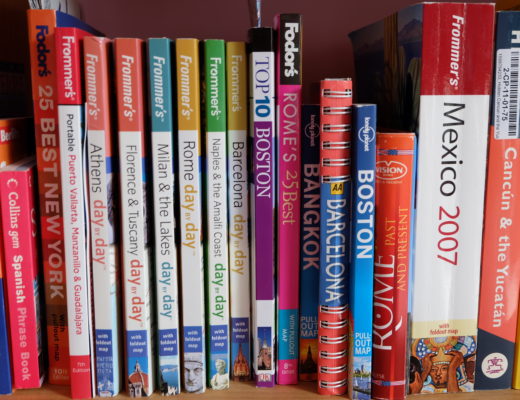You don’t need me to tell you that climate change is real. We’ve seen protest after protest, and incredibly inspiring young people, like Greta Thunberg, standing up to educate and inform leaders, decision-makers, and everyday people like you (and I) about how our careless actions have caused our planet to be in a serious problem.
At least 8 million tons of plastic enter our oceans each year through single-use products. That’s similar to emptying a garbage truck of plastic into an ocean every minute. We’re seeing animal after animal suffers from OUR problems, and I even learned in the documentary, Blue, that basically all the fish and seafood we consume now contains some amount of microplastics.
Back when I was laid off from my job in 2018, I was bored and starved to use my brain again, so I found myself deeply fascinated by the book Plastic Free. Although this book came out a few years ago now, it contained so much valuable information about single-use products, alternatives, and the serious problem our world is facing.
The thing is, when you read things like this, or see the scary stats on TV, you feel like it’s too far gone. That there’s no way to reverse what we’ve done to our planet. But the truth is, if every single person made the smallest change in their lifestyle it could make a big impact. I don’t think it’s realistic to say you’re never going to buy or use plastic again, but there are ways to lower your usage of single-use products in your life.
Although this is a travel blog, and this post isn’t directly related to travel, in order to have this beautiful planet to continue to travel around, we need to take action. Here are some of the ways I’m doing my part. Now tell me, what are you doing to make a change?
In the bathroom
One of the first places I started with lowering my plastic usage was the single-use products you’d find in my bathroom. There are so many ways we use plastic in our bathroom and don’t even think twice about it. On top of that, we don’t keep a recycling bin in our bathrooms meaning we toss things in the trash can without even a second thought.
Toothbrushes
Let’s start with toothbrushes first. We’re told to replace our toothbrush every three months. That’s four toothbrushes a year per person. In North America alone that’s 2.3 billion toothbrushes that will end up in landfills in one year. How do we change this? Look for an environmentally friendly option like bamboo. Although the bristles won’t biodegrade, you can cut them off and plant the handle in the ground to decompose. I’ve even found bamboo toothbrushes for cheap at Winners or HomeSense in Canada.
Tip: I’ll also say no to the little goodie bags of floss and toothbrushes they give you when you go to the dentist.
If you refuse to change from plastic brushes, or have some to use up, you can always recycle them through one of these great programs that use them to make plastic lumber and other things.
Refill, refill, refill
In most major cities, there has been a rise in stores that offer the ability to refill your bottles of shampoo, conditioner, body wash, moisturizers, hand soap, etc. I go to BareMarket in Toronto, but there’s also several other options you can find listed here. What I’ve been doing is replacing/refilling my bottles of things in my bathroom as I run out of the previous product I bought in that bottle.
Washable fabric over trash
Another thing I’ve replaced in my bathroom is the use of disposable cotton makeup remover pads or cotton balls. These are so unnecessary as they sell reusable ones out there that you just throw in the wash. Alternatively, use a face cloth or towel to remove your makeup! I even found a tutorial on Pinterest to make your own!
Paying attention to what is recyclable
There are so many things in your bathroom you don’t think twice about and toss in the trash. Toilet paper rolls are a big one, for example, but also for me, blister packs that my daily contact lenses come in. Some companies like Bausch & Lomb offer a recycling program, but they’re not available in every country. However, most people don’t realize that the blister pack is actually recyclable in some cities. Just take off the foil top and ensure when you put it in the recycling bin it’s inside a bag or can so the little pieces don’t get lost or end up on the ground. Another big offender is the outer packaging of things like toilet paper, sanitary napkins, etc.
If you’re lazy, keep a recycling bin in your bathroom, and when in doubt, a simple Google search in your city can give you the answer.
Single-use products in the kitchen
This can be an incredibly challenging place to eliminate plastic and single-use products because so many groceries you can’t buy without the plastic packaging, however, there are some easy switches you can make:
- Bring your own containers to a bulk store to refill things like spices, grains, pasta, oil, vinegar, etc.
- Opt for the option not wrapped in plastic. For example, field cucumbers versus english cucumbers in the grocery store because they’re not wrapped in plastic
- When there is a plastic-free option, buy it instead
- Bring reusable produce bags, or just don’t use produce bags at all. You don’t need them
- An obvious one yet many people still forget, bring reusable bags with you every time you grocery shop
- When you do buy products in plastic, like bread for example, wash and reuse the plastic bag it comes in versus buying Ziploc’s
- Buy reusable snack bags, beeswax sheets to use instead of saran wrap, and don’t forget, tin foil can be recycled!
- Make your own lunches, tea/coffee in the mornings to avoid buying food out and takeout containers
- Switch to metal, or bamboo straws instead of plastic, and have one with you wherever you go
- Say no to meal kits like Chef’s Plate or Hello Fresh because almost everything comes in a million plastic bags or containers
- Bring your reusable water bottle, or drink out of the tap! If you live in a first world country, there’s no need for plastic water bottles
16 billion coffee cups are used each year. The worst part? They are coated in a plastic laminate that makes them non-recyclable.
If you really want to make a big step here, there have been some zero waste grocery stores popping up like Unboxed Market in Toronto (a simple search in your city will give you options). These places sell everything in bulk, even things like milk, so you can easily buy what you need, and in your own container!
For me one of the biggest things I’ve done is just overall pay more attention to the waste I’m producing. I regularly Google ways to recycle certain items the right way, and am more conscious about buying decisions I make. The other day, for example, I was craving a can of Coke, but the store I was at only had plastic bottles of it. Instead I opted for something different in glass, because I refused to buy the plastic bottle for something I didn’t actually need, just wanted. Being more hyper aware about your plastic use can make the world of a difference.
Make sure to speak up and complain when you come across a business that is going overkill on single-use plastic!
How are you cutting plastic in your home and every day life?




No Comments